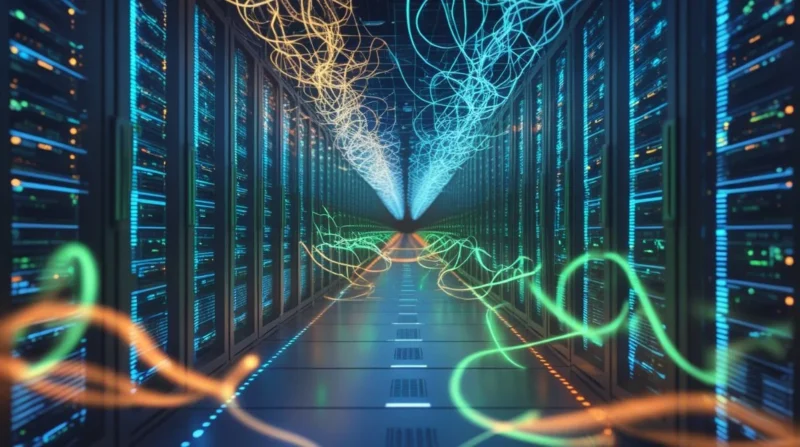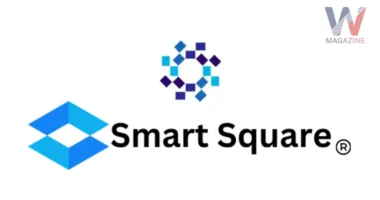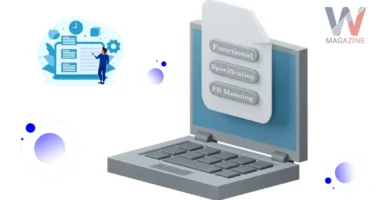Table of Contents
- What is Electronic Data Processing?
- Components of Electronic Data Processing (EDP)
- Types of Electronic Data Processing (EDP)
- Advantages of EDP
- Challenges of EDP
- Real-World Applications of EDP
- The Future of Electronic Data Processing (EDP)
- 1. Integration of Artificial Intelligence (AI)
- 2. Emergence of Edge Computing
- 3. Advancements in In-Memory Processing
- 4. Adoption of Neuromorphic Computing
- 5. Implementation of Hybrid Transaction/Analytical Processing (HTAP)
- 6. Utilization of Approximate Computing
- 7. Enhanced Data Security Measures
- 8. Development of Advanced Data Transmission Technologies
- Conclusion
In today’s digital age, handling vast amounts of information efficiently is crucial. Electronic Data Processing (EDP) plays a vital role in this process, enabling organizations to manage data effectively. Let’s discuss what EDP is, how it works, its benefits, and the challenges it presents.
What is Electronic Data Processing?
Electronic Data Processing, commonly abbreviated as EDP, refers to the automated method of processing data using electronic devices like computers. It involves collecting, organizing, analyzing, and storing data to produce meaningful information. Unlike manual data processing, EDP enhances speed, accuracy, and efficiency.
Components of Electronic Data Processing (EDP)
Electronic Data Processing (EDP) is the automated method of processing data using electronic devices, primarily computers. It involves collecting, manipulating, storing, and disseminating data to produce meaningful information. Understanding the components of EDP is essential for organizations aiming to leverage technology for efficient data management. Let’s discuss the fundamental components that constitute an EDP system.
1. Hardware
Hardware encompasses the physical devices required for data processing. These devices perform various functions, from data input to storage and output. Key hardware components include:
- Input Devices: Tools like keyboards, mice, scanners, and barcode readers that allow users to enter data into the system.
- Central Processing Unit (CPU): Often referred to as the brain of the computer, the CPU executes instructions and performs calculations necessary for data processing.
- Memory Units: These include:
- Primary Storage (RAM): Temporary storage that holds data and instructions currently in use.
- Secondary Storage: Permanent storage devices like hard drives and solid-state drives that retain data even when the system is powered off.
- Output Devices: Monitors, printers, and speakers that present processed data to users.
- Networking Equipment: Routers, switches, and modems that facilitate data communication between different parts of the system and external networks.
2. Software
Software comprises the programs and applications that instruct hardware on how to process data. It can be categorized into:
- System Software: Includes operating systems like Windows, macOS, and Linux that manage hardware resources and provide a platform for application software.
- Application Software: Programs designed for specific tasks, such as:
- Data Entry Software: Tools like Microsoft Excel or customized point-of-sale systems for entering and managing data.
- Accounting Software: Applications that handle financial transactions and reporting.
- Analytics Software: Programs that analyze data to extract insights and support decision-making.
- Scheduling Software: Tools that manage timelines, appointments, and resource allocation.
- Utility Software: Programs that perform maintenance tasks, such as data backup, antivirus protection, and system optimization.
3. Procedures
Procedures refer to the standardized methods and protocols that govern data processing activities. They ensure consistency, accuracy, and efficiency in handling data. Key procedures include:
- Data Collection: Gathering raw data from various sources.
- Data Entry: Inputting collected data into the system using input devices.
- Data Processing: Manipulating data through sorting, calculating, and summarizing to produce meaningful information.
- Data Storage: Saving processed data in appropriate storage devices for future retrieval.
- Data Output: Presenting processed information through output devices or reports.
- Data Backup and Recovery: Creating copies of data to prevent loss and establishing methods to restore data in case of system failures.
4. Personnel
Human resources are integral to the operation and management of EDP systems. Personnel roles include:
- System Analysts: Professionals who design and implement information systems tailored to organizational needs.
- Programmers: Individuals who write and maintain software programs that facilitate data processing.
- Data Entry Operators: Staff responsible for accurately inputting data into the system.
- Database Administrators: Experts who manage and maintain databases, ensuring data integrity and security.
- IT Support Staff: Technicians who provide assistance in troubleshooting hardware and software issues.
5. Data Control and Security
Ensuring the accuracy, integrity, and confidentiality of data is paramount. Components involved in data control and security include:
- Data Validation: Processes that check data for accuracy and completeness during entry.
- Access Controls: Mechanisms that restrict data access to authorized personnel only.
- Encryption: Techniques that convert data into coded formats to prevent unauthorized access.
- Audit Trails: Logs that record data access and modifications for accountability and monitoring.
- Compliance Measures: Adherence to legal and regulatory standards governing data protection and privacy.
6. Data Storage Systems
Efficient data storage is critical for quick retrieval and long-term preservation. Storage systems vary based on capacity, speed, and accessibility:
- Magnetic Storage: Hard drives and tapes that offer large storage capacities.
- Solid-State Storage: SSDs that provide faster data access speeds and durability.
- Optical Storage: CDs and DVDs are used for archiving data.
- Cloud Storage: Online storage solutions that offer scalability and remote access.
7. Networking Components
Networking enables data sharing and communication between different parts of the EDP system and external entities:
- Local Area Networks (LANs): Connect computers within a limited area, like an office.
- Wide Area Networks (WANs): Link systems across broader geographical areas.
- Internet Connectivity: Facilitates access to online resources and cloud-based services.
- Firewalls and Security Protocols: Protect the network from unauthorized access and cyber threats.
Types of Electronic Data Processing (EDP)
Electronic Data Processing (EDP) refers to the automated method of processing data using electronic devices, primarily computers. Different types of EDP cater to various organizational needs, each with its unique characteristics and applications. Let’s discuss the primary types of EDP:
1. Batch Processing
Batch processing involves collecting data over a period and processing it all at once. This method is efficient for tasks that don’t require immediate results.
Key Features:
- Scheduled Processing: Tasks are executed at predetermined times, often during off-peak hours.
- Minimal User Interaction: Once initiated, the process runs without further human intervention.
- High Volume Handling: Suitable for processing large volumes of data.
Applications:
- Payroll systems
- Utility billing
- Report generation
Advantages:
- Cost-effective for large data sets
- Efficient use of system resources
Disadvantages:
- Delayed processing results
- Less flexibility for urgent tasks
2. Real-Time Processing
Real-time processing handles data instantly as it is inputted, providing immediate output. This method is crucial for time-sensitive operations.
Key Features:
- Immediate Response: Processes data instantly upon entry.
- Continuous Operation: Systems run continuously to handle incoming data.
- High Reliability: Ensures timely and accurate data processing.
Applications:
- Air traffic control systems
- Online banking transactions
- Emergency response systems
Advantages:
- Immediate data availability
- Enhanced decision-making capabilities
Disadvantages:
- Requires robust infrastructure
- Higher operational costs
3. Online Processing
Online processing allows users to interact directly with the system, entering and retrieving data in real-time.
Key Features:
- User Interaction: Users can input and access data directly.
- Immediate Feedback: The System provides instant responses to user queries.
- Concurrent Access: Multiple users can access the system simultaneously.
Applications:
- Online shopping platforms
- Reservation systems
- Customer service portals
Advantages:
- Enhanced user experience
- Real-time data updates
Disadvantages:
- Potential for system overload
- Security vulnerabilities
4. Distributed Processing
Distributed processing involves multiple computers working together over a network to process data.
Key Features:
- Resource Sharing: Systems share processing tasks across multiple machines.
- Scalability: Easy to add more machines to handle increased load.
- Fault Tolerance: Failure in one machine doesn’t halt the entire process.
Applications:
- Cloud computing services
- Global financial systems
- Scientific simulations
Advantages:
- Improved performance
- Enhanced reliability
Disadvantages:
- Complex system management
- Potential data synchronization issues
Advantages of EDP
Implementing EDP offers numerous benefits:
- Speed: Automated systems process data much faster than manual methods.
- Accuracy: Minimizes human errors, ensuring data integrity.
- Efficiency: Streamlines operations, reducing redundancy and improving productivity.
- Cost-Effective: Over time, EDP reduces operational costs by minimizing manual labor and errors.
- Data Storage and Retrieval: Facilitates easy storage and quick retrieval of vast amounts of data.
- Scalability: EDP systems can be scaled to accommodate growing data needs.
Challenges of EDP
Despite its advantages, EDP also presents certain challenges:
- Initial Setup Costs: Implementing EDP systems can require significant investment in hardware and software.
- Security Risks: Electronic data is susceptible to cyber threats, necessitating robust security measures.
- Dependence on Technology: System failures or technical issues can disrupt operations.
- Training Requirements: Staff need proper training to operate and manage EDP systems effectively.
- Maintenance: Regular updates and maintenance are essential to keep the system running smoothly.
Real-World Applications of EDP
EDP is integral to various sectors:
- Healthcare: Managing patient records and scheduling appointments.
- Finance: Processing transactions and maintaining account information.
- Retail: Managing inventory and sales data.
- Education: Handling student records and academic information.
- Government: Managing citizen data and public records.
The Future of Electronic Data Processing (EDP)
Electronic Data Processing (EDP) has been a cornerstone of organizational operations, facilitating efficient data management and decision-making. As technology evolves, EDP is poised to undergo significant transformations, integrating advanced systems and methodologies to meet the growing demands of data-centric environments. This article discusses the emerging trends and technologies shaping the future of EDP.
1. Integration of Artificial Intelligence (AI)
Artificial Intelligence is revolutionizing EDP by introducing intelligent data processing capabilities. AI algorithms can analyze vast datasets to identify patterns, predict outcomes, and automate decision-making processes. This integration enhances the efficiency and accuracy of data processing tasks, enabling organizations to respond swiftly to dynamic market conditions.
2. Emergence of Edge Computing
Edge computing brings data processing closer to the data source, reducing latency and bandwidth usage. By processing data at the edge of the network, organizations can achieve real-time analytics and faster response times. This approach is particularly beneficial for applications requiring immediate data processing, such as IoT devices and autonomous systems.
3. Advancements in In-Memory Processing
In-memory processing stores data in the system’s main memory (RAM) rather than on traditional disk storage, significantly accelerating data retrieval and processing speeds. This technology supports real-time analytics and is instrumental in applications where speed is critical, such as financial transactions and online customer interactions.
4. Adoption of Neuromorphic Computing
Neuromorphic computing mimics the neural structure of the human brain, enabling systems to process information more efficiently and adaptively. This approach promises to enhance EDP by providing low-power, high-speed data processing capabilities, suitable for complex pattern recognition and sensory data analysis.
5. Implementation of Hybrid Transaction/Analytical Processing (HTAP)
HTAP systems combine transactional and analytical data processing within a single platform, eliminating the need for separate systems. This integration allows for real-time analytics on transactional data, facilitating immediate insights and informed decision-making.
6. Utilization of Approximate Computing
Approximate computing introduces a paradigm where systems can deliver results that are “good enough” rather than perfectly accurate, significantly reducing energy consumption and processing time. This approach is suitable for applications like multimedia processing and machine learning, where exact precision is not always necessary.
7. Enhanced Data Security Measures
As data becomes increasingly valuable, securing it is paramount. Future EDP systems will incorporate advanced security protocols, including quantum-resistant cryptography and AI-driven threat detection, to safeguard data integrity and privacy.
8. Development of Advanced Data Transmission Technologies
Innovations in data transmission, such as the development of spin photo detectors, aim to overcome current limitations in data transfer speeds. These technologies promise to enhance the efficiency of data centers and support the growing demands of AI applications.
Conclusion
Electronic Data Processing is a cornerstone of modern data management, offering speed, accuracy, and efficiency. While it presents certain challenges, the benefits it brings to various sectors are undeniable. Understanding EDP is essential for anyone looking to navigate the digital landscape effectively.
Related Topic: CÑIMS: Transforming Data Processing & Predictive Analytics









